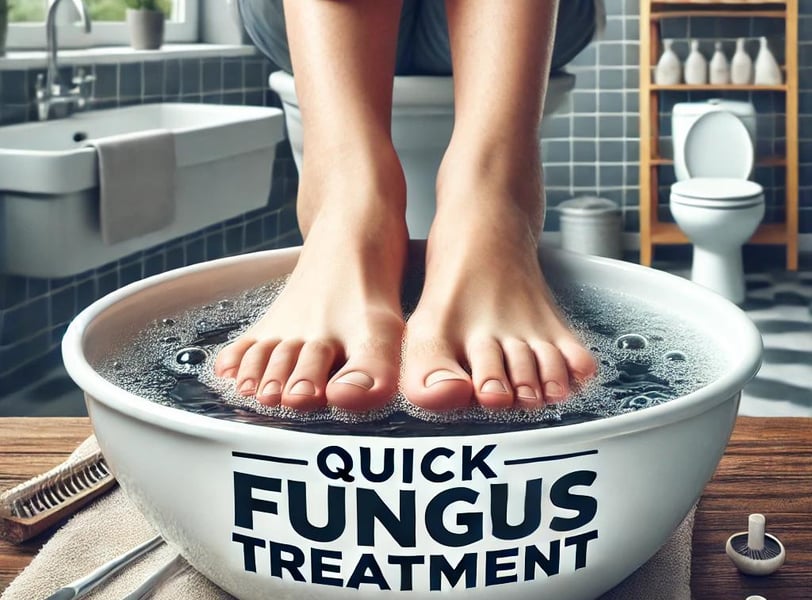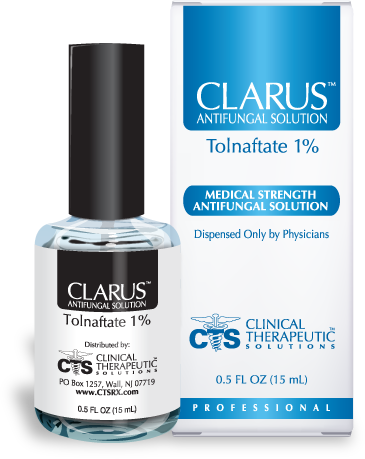The Disturbing Truth About Toenail Fungus: What You Need to Know
Toenail fungus is more than just an aesthetic concern – it can lead to serious discomfort and complications if left untreated. In this article, we dive into the disturbing truth behind toenail fungus, its causes, and why it's so hard to get rid of. We’ll also discuss natural treatments, preventive measures, and when it's time to seek medical help. Don’t let toenail fungus take over your health – learn how to fight back and protect your feet with these essential tips.
HOME DISPLAY ARTICLES
James B.
2/21/20257 min read
The Disturbing Truth About Toenail Fungus
Toenail fungus—also known as onychomycosis—is a condition that many people either ignore, avoid talking about, or simply hope will go away on its own. It’s often dismissed as a cosmetic issue, but the truth is that toenail fungus can cause significant discomfort, embarrassment, and even lead to more serious health concerns if left untreated. Despite being one of the most common foot problems, many people don't fully understand the causes of toenail fungus, how it develops, or how to treat it effectively.
In this article, we’ll delve into the disturbing truth about toenail fungus, how it can affect your health, and most importantly, what you can do to prevent and treat it. We’ll cover everything from the symptoms to the most effective natural and medical remedies. So, if you've been battling toenail fungus or simply want to know how to protect your feet, read on—there’s a lot more to toenail fungus than meets the eye!
What is Toenail Fungus?
Toenail fungus occurs when a fungus—often dermatophytes—invades the nail and its surrounding skin. It can affect both the toenails and fingernails, but toenail fungus is far more common. The fungus thrives in warm, damp environments, making your feet an ideal breeding ground. The infection usually starts at the edge of the nail and gradually spreads inward, causing the nail to discolor, thicken, and become brittle.
Toenail fungus is typically not a life-threatening condition, but it can be incredibly uncomfortable and frustrating to deal with. As the infection progresses, it can cause pain, difficulty walking, and a reduced quality of life. If left untreated, toenail fungus can lead to more severe infections, especially in individuals with weakened immune systems, diabetes, or poor circulation.
Causes of Toenail Fungus
The primary cause of toenail fungus is exposure to fungal spores, which are present in environments that are warm, dark, and moist. Some of the most common causes of toenail fungus include:
1. Exposure to Fungal Spores
Toenail fungus is highly contagious, and fungal spores can be found in places like:
Public showers, pools, or gyms: These moist environments provide ideal conditions for the growth of fungi.
Tight-fitting shoes or sweaty socks: Wearing shoes that don’t allow your feet to breathe, or socks that trap moisture, creates the perfect environment for fungi to thrive.
2. Injuries to the Nail
Trauma or injury to the toenail can allow fungal spores to enter the nail bed, leading to an infection. Even a small injury, like stubbing your toe, can create an opening for fungi to infiltrate the nail.
3. Weakened Immune System
People with compromised immune systems are more susceptible to fungal infections. Conditions like diabetes, HIV/AIDS, or any other condition that weakens your immune defenses increase the likelihood of developing toenail fungus.
4. Poor Circulation
Individuals with poor circulation, especially those with conditions like peripheral artery disease (PAD), are at a higher risk for toenail fungus. Poor circulation makes it harder for the body to fight off infections, allowing fungi to take hold more easily.
5. Age
As we age, our immune systems naturally weaken, and the blood flow to our extremities may decrease. This makes older adults more susceptible to toenail fungus infections. Additionally, as we get older, the nails become more brittle, making it easier for fungi to invade.
Say goodbye to toenail fungus and hello to healthy, beautiful nails! Don’t let fungus hold you back—discover the solution that works. Click below to take the first step towards clear, fungus-free nails!"
👉 Say Goodbye to Toenail Fungus
Symptoms of Toenail Fungus
Toenail fungus doesn’t always cause immediate symptoms, which is one reason why it often goes unnoticed or untreated for a long time. However, as the infection progresses, several telltale signs can indicate the presence of toenail fungus:
1. Discoloration of the Nail
One of the first visible signs of toenail fungus is a change in the color of the affected nail. The nail may become yellow, brown, or white, and the discoloration often starts at the tip or edge of the nail.
2. Thickened Nails
Toenail fungus can cause the affected nail to become thickened and difficult to trim. As the infection spreads, the nail may become more deformed, brittle, and prone to breakage.
3. Crumbly or Brittle Nails
As the fungus continues to invade the nail, it can cause the nail to crumble, chip, or break apart easily. This can lead to painful cracks and tears, which may become infected and worsen the condition.
4. Separation from the Nail Bed
In more advanced cases, the toenail may start to separate from the nail bed, creating a gap between the nail and the skin. This condition is called onycholysis and can cause pain, swelling, and increased vulnerability to further infection.
5. Odor
A foul odor may be present as the fungus proliferates in the nail. This is due to the build-up of fungi and bacteria beneath the nail, which produces a noticeable, unpleasant smell.
6. Pain or Discomfort
If left untreated, toenail fungus can cause significant pain or discomfort. The affected nail may become swollen, inflamed, and tender to the touch, especially when pressure is applied. This can make walking or wearing shoes painful.
How to Prevent Toenail Fungus
While toenail fungus is common, there are steps you can take to prevent it from developing or recurring. By practicing good foot hygiene and taking preventative measures, you can reduce the likelihood of getting toenail fungus.
1. Keep Your Feet Dry and Clean
Since fungus thrives in warm, moist environments, it’s important to keep your feet clean and dry. Make sure to wash your feet daily with soap and water, and dry them thoroughly, especially between the toes, where moisture tends to accumulate.
2. Wear Breathable Shoes and Socks
Choose shoes made of breathable materials, such as leather or mesh, that allow your feet to get adequate ventilation. Avoid wearing tight shoes that cause your feet to sweat excessively. Wearing moisture-wicking socks can help keep your feet dry and reduce the risk of fungal infections.
3. Use Antifungal Powder or Spray
If you’re prone to fungal infections or sweat excessively, consider using an antifungal powder or spray on your feet before putting on socks and shoes. These products help kill fungal spores and prevent infections from developing.
4. Avoid Walking Barefoot in Public Places
Public showers, locker rooms, and swimming pools are common places where toenail fungus spreads. Always wear flip-flops or shower shoes in these areas to protect your feet from exposure to fungal spores.
5. Trim Your Nails Regularly
Trim your toenails straight across and avoid cutting them too short. Keeping your nails neat and well-maintained helps prevent injury, which can open the door for fungal infections. Be sure to clean your nail clippers regularly to avoid spreading fungus.
Say goodbye to toenail fungus and hello to healthy, beautiful nails! Don’t let fungus hold you back—discover the solution that works. Click below to take the first step towards clear, fungus-free nails!"
👉 Say Goodbye to Toenail Fungus
Natural Treatments for Toenail Fungus
While it’s always a good idea to consult with a healthcare professional if you suspect you have toenail fungus, there are several natural remedies that may help treat the condition. These remedies can be used alongside professional treatments or for mild cases that don’t require prescription medication.
1. Tea Tree Oil
Tea tree oil is known for its powerful antifungal and antiseptic properties. It can be applied directly to the affected nail to help kill the fungus and promote healing.
To use tea tree oil:
Mix a few drops of tea tree oil with a carrier oil (such as coconut or olive oil) to avoid irritation.
Apply the mixture to the affected nail using a cotton ball or swab.
Repeat this process 2-3 times a day until symptoms improve.
2. Apple Cider Vinegar
Apple cider vinegar has natural antifungal properties that can help kill the fungus and restore balance to the skin. You can soak your feet in a mixture of apple cider vinegar and warm water, or apply it directly to the affected nail.
To use apple cider vinegar:
Mix equal parts apple cider vinegar and water in a bowl.
Soak your feet for 15-20 minutes a few times a week.
Alternatively, you can apply a cotton ball soaked in apple cider vinegar directly to the nail.
3. Garlic
Garlic contains allicin, a compound with powerful antifungal properties. Crushing fresh garlic and applying it to the affected area may help fight off the infection.
To use garlic:
Crush a garlic clove and mix it with a small amount of olive oil.
Apply the paste to the affected toenail and leave it on for 15-20 minutes before rinsing off.
Repeat this process 2-3 times a week.
4. Coconut Oil
Coconut oil has antifungal, moisturizing, and healing properties. It can help hydrate the nail while fighting the fungal infection.
To use coconut oil:
Apply a thin layer of coconut oil to the affected toenail after cleaning and drying the area.
Repeat this process 2-3 times a day until symptoms improve.
Medical Treatments for Toenail Fungus
For more severe cases of toenail fungus, you may need to seek medical treatment. Your doctor may recommend one or more of the following treatments:
1. Topical Antifungal Medications
Over-the-counter and prescription-strength antifungal creams, ointments, and lacquers are commonly used to treat toenail fungus. These products are applied directly to the affected nail and help kill the fungus over time.
2. Oral Antifungal Medications
In more severe cases, your doctor may prescribe oral antifungal medications, which work by targeting the infection from the inside. These medications are typically taken for several weeks to months, depending on the severity of the infection.
3. Laser Treatment
Laser treatment is a newer option for treating toenail fungus. It involves using a laser to target and destroy the fungus beneath the nail. This treatment is typically safe and effective but may require multiple sessions.
Conclusion: Don’t Let Toenail Fungus Control Your Life
Toenail fungus may be common, but that doesn’t mean you have to live with it. By understanding the causes, symptoms, and natural remedies available to you, you can take control of your foot health and restore your nails to their healthy, vibrant state. Whether you opt for natural treatments or professional care, the key is to stay consistent and be patient.
Remember, the earlier you address toenail fungus, the easier it will be to treat. So, if you notice any signs of toenail fungus, take action and start implementing these natural remedies today. Your feet will thank you!
Say goodbye to toenail fungus and hello to healthy, beautiful nails! Don’t let fungus hold you back—discover the solution that works. Click below to take the first step towards clear, fungus-free nails!"





